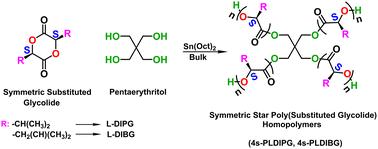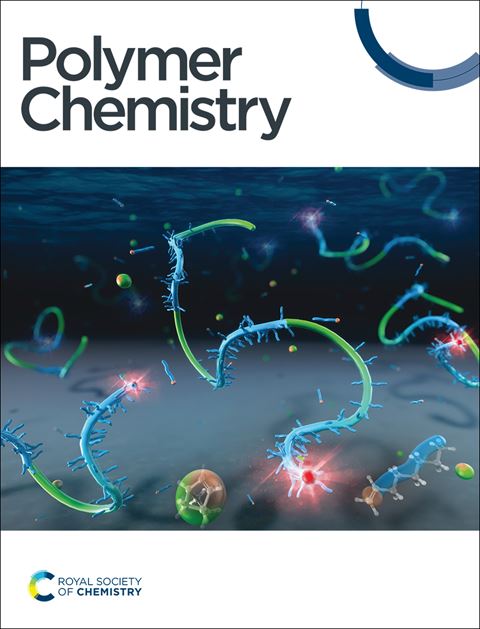对称星型聚(取代羟基)均聚物及其表面特性
IF 3.9
2区 化学
Q2 POLYMER SCIENCE
引用次数: 0
摘要
具有预定长度和长度的星形聚(取代糖醇酯)(s-PSG)均聚物是聚乳酸和聚糖醇酯的替代品,由于其几何和结构的差异,可以为调节其物理性质提供很大的机会,例如玻璃化转变温度(Tg)、结晶度、疏水性和表面特性。本文报道了在熔融条件下,以锡(II) 2-乙基己酸盐[Sn(Oct)2]为催化剂,季戊四醇为引发剂,通过开环聚合(ROP)的方法合成了s-PSG均聚物,包括四臂对称聚l -二异丙基乙醇酸酯(2s - pldipg)和聚l -二异丁基乙醇酸酯(2s - pldibg)。4s-PLDIPG 8的Tg、熔融温度Tm和结晶度比4s-PLDIPG 10低(Tg: 33.7℃vs 35.9℃;Tm: 143.9℃vs. 183.4℃;Xc: 16.7% vs. 19.1%),这是由于其单臂Mn较低。4s-PLDIPG 8的Tm和结晶度也显著低于其线性对应的PLDIPG 17 (Tm: 143.9°C vs. 190.6°C;Xc: 16.7% vs. 26.7%)由于臂长短。随着s-PSG均聚物侧链长度的增加,薄膜的水接触角和表面粗糙度值相应增大,而表面自由能减小。侧链长度与表面性能之间的相关性通过SEM和AFM进一步验证,证实了延伸侧链对聚合物表面特性的影响。本文章由计算机程序翻译,如有差异,请以英文原文为准。


Symmetric star poly(substituted glycolide) homopolymers and their surface properties†
Well-defined star poly(substituted glycolide) (s-PSG) homopolymers with predetermined lengths and numbers of arms, which are alternatives to polylactides and polyglycolides, may offer great opportunity for the modulation of their physical properties, such as glass transition temperature (Tg), crystallinity, hydrophobicity, and surface characteristics due to their geometric and structural differences. Herein, we report the synthesis of s-PSG homopolymers, including a four-armed symmetrical poly(l-diisopropyl glycolide) (4s-PLDIPG) and poly(l-diisobutyl glycolide) (4s-PLDIBG) from the ring opening polymerization (ROP) of their monomers in the presence of tin(ii) 2-ethylhexanoate [Sn(Oct)2] as a catalyst and pentaerythritol as an initiator via a core-first approach under melt conditions. 4s-PLDIPG exhibits lower Tg, melting temperature (Tm) and crystallinity % than 4s-PLDIPG (Tg: 33.7 °C vs. 35.9 °C; Tm: 143.9 °C vs. 183.4 °C; Xc: 16.7% vs. 19.1%) due to its lower Mn per arm. 4s-PLDIPG also has a dramatically lower Tm and crystallinity % than its linear counterpart PLDIPG (Tm: 143.9 °C vs. 190.6 °C; Xc: 16.7% vs. 26.7%) due to its short arm length. As the side chain length of s-PSG homopolymers increased, there was a corresponding increase in the water contact angles and surface roughness values of the thin films, while the surface free energy decreased. This correlation between side chain length and surface properties was further validated by SEM and AFM profiles, which confirmed the impact of extended side chains on the polymer's surface characteristics.
求助全文
通过发布文献求助,成功后即可免费获取论文全文。
去求助
来源期刊

Polymer Chemistry
POLYMER SCIENCE-
CiteScore
8.60
自引率
8.70%
发文量
535
审稿时长
1.7 months
期刊介绍:
Polymer Chemistry welcomes submissions in all areas of polymer science that have a strong focus on macromolecular chemistry. Manuscripts may cover a broad range of fields, yet no direct application focus is required.
 求助内容:
求助内容: 应助结果提醒方式:
应助结果提醒方式:


